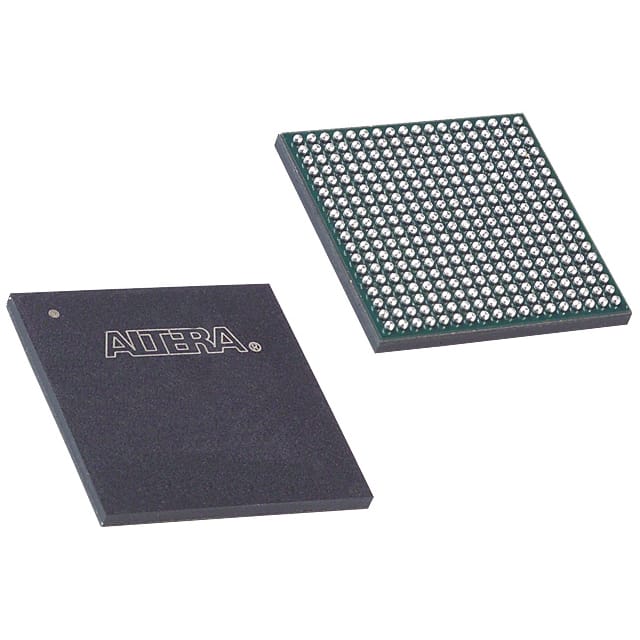Lihat spesifikasi untuk detail produk.

EP1C20F324C7
Product Overview
- Category: Programmable Logic Device (PLD)
- Use: EP1C20F324C7 is a PLD that can be programmed to perform various logic functions.
- Characteristics: It offers high performance, low power consumption, and flexibility in designing complex digital circuits.
- Package: The EP1C20F324C7 comes in a compact 324-pin FineLine BGA package.
- Essence: This PLD is designed to provide efficient and reliable programmable logic solutions for a wide range of applications.
- Packaging/Quantity: The EP1C20F324C7 is typically sold individually or in small quantities.
Specifications
- Logic Elements: The EP1C20F324C7 contains 20,000 logic elements, which can be configured as lookup tables, registers, or other functional units.
- Memory: It includes 288 kilobits of embedded memory for storing data or configuration information.
- Clocking: The device supports up to four global clock networks and multiple phase-locked loops (PLLs) for precise timing control.
- I/O Interfaces: EP1C20F324C7 provides a variety of I/O interfaces, including LVDS, SSTL, and LVTTL, allowing easy integration with different external devices.
- Operating Voltage: It operates at a voltage range of 1.2V to 3.3V, making it compatible with a wide range of systems.
Pin Configuration
The EP1C20F324C7 has a detailed pin configuration, which can be found in the product datasheet provided by the manufacturer.
Functional Features
- Flexibility: EP1C20F324C7 offers a high degree of flexibility, allowing designers to implement custom logic functions tailored to their specific requirements.
- High Performance: With its large number of logic elements and embedded memory, the device can handle complex digital circuits efficiently.
- Low Power Consumption: The PLD is designed to minimize power consumption, making it suitable for battery-powered applications.
- Easy Integration: The variety of I/O interfaces simplifies the integration of the EP1C20F324C7 with other devices in a system.
Advantages and Disadvantages
Advantages: - High flexibility in designing custom logic functions - Efficient handling of complex digital circuits - Low power consumption - Easy integration with other devices
Disadvantages: - Limited availability of alternative models - Higher cost compared to simpler programmable logic devices
Working Principles
The EP1C20F324C7 operates based on the principles of programmable logic. It consists of configurable logic blocks (CLBs), interconnect resources, and input/output blocks (IOBs). The CLBs can be programmed to perform various logic functions, while the interconnect resources provide routing paths between different blocks. The IOBs facilitate communication between the PLD and external devices.
Application Field Plans
The EP1C20F324C7 can be used in various application fields, including but not limited to: - Telecommunications - Industrial automation - Consumer electronics - Automotive systems - Medical devices
Alternative Models
While the EP1C20F324C7 is a popular choice for many applications, there are alternative models available from other manufacturers. Some notable alternatives include: - Xilinx Spartan-6 FPGA series - Altera Cyclone IV series - Lattice Semiconductor ECP5 series
These alternative models offer similar functionality and can be considered as substitutes depending on specific requirements.
Note: This entry provides a brief overview of the EP1C20F324C7. For more detailed information, please refer to the product datasheet and documentation provided by the manufacturer.
Sebutkan 10 pertanyaan dan jawaban umum terkait penerapan EP1C20F324C7 dalam solusi teknis
Sure! Here are 10 common questions and answers related to the application of EP1C20F324C7 in technical solutions:
Q1: What is EP1C20F324C7? A1: EP1C20F324C7 is a specific model of Field Programmable Gate Array (FPGA) manufactured by Intel.
Q2: What are the key features of EP1C20F324C7? A2: Some key features of EP1C20F324C7 include 20,000 logic elements, 324 user I/O pins, and support for various communication protocols.
Q3: What are the typical applications of EP1C20F324C7? A3: EP1C20F324C7 is commonly used in applications such as digital signal processing, industrial automation, robotics, and high-performance computing.
Q4: How can EP1C20F324C7 be programmed? A4: EP1C20F324C7 can be programmed using Hardware Description Languages (HDLs) like VHDL or Verilog, which describe the desired functionality of the FPGA.
Q5: Can EP1C20F324C7 be reprogrammed after deployment? A5: Yes, EP1C20F324C7 is a reprogrammable FPGA, allowing for updates and modifications to the implemented design.
Q6: What tools are available for programming EP1C20F324C7? A6: Intel provides Quartus Prime software suite, which includes tools for designing, simulating, and programming EP1C20F324C7.
Q7: What are the power requirements for EP1C20F324C7? A7: EP1C20F324C7 typically operates at a voltage range of 1.2V to 3.3V, with power consumption varying based on the design and usage.
Q8: Can EP1C20F324C7 interface with other components or devices? A8: Yes, EP1C20F324C7 supports various communication protocols like UART, SPI, I2C, and can interface with external components or devices.
Q9: Are there any limitations or considerations when using EP1C20F324C7? A9: Some considerations include the need for proper cooling, managing power consumption, and ensuring compatibility with other system components.
Q10: Where can I find more information about EP1C20F324C7? A10: You can refer to the official documentation provided by Intel, including datasheets, user guides, and application notes, for detailed information about EP1C20F324C7.
Please note that the answers provided here are general and may vary depending on specific requirements and use cases.

